Lighting doesn’t just chase away the shadows in a garage—it shapes how confidently you tinker with tools, detail a car, or walk in from a late-night drive. Today’s garage lighting choices stretch far beyond a single bare bulb, offering energy savings, smarter controls, and sharper task visibility. From ultra-bright LED panels that mimic daylight to clever motion-sensor fixtures that only shine when needed, the right mix can transform even the gloomiest bay into a productive, welcoming workspace. Ready for inspiration? Let’s explore twenty practical garage-lighting ideas you can start planning this weekend.
1. LED Wraparound Fixtures Flood the Ceiling
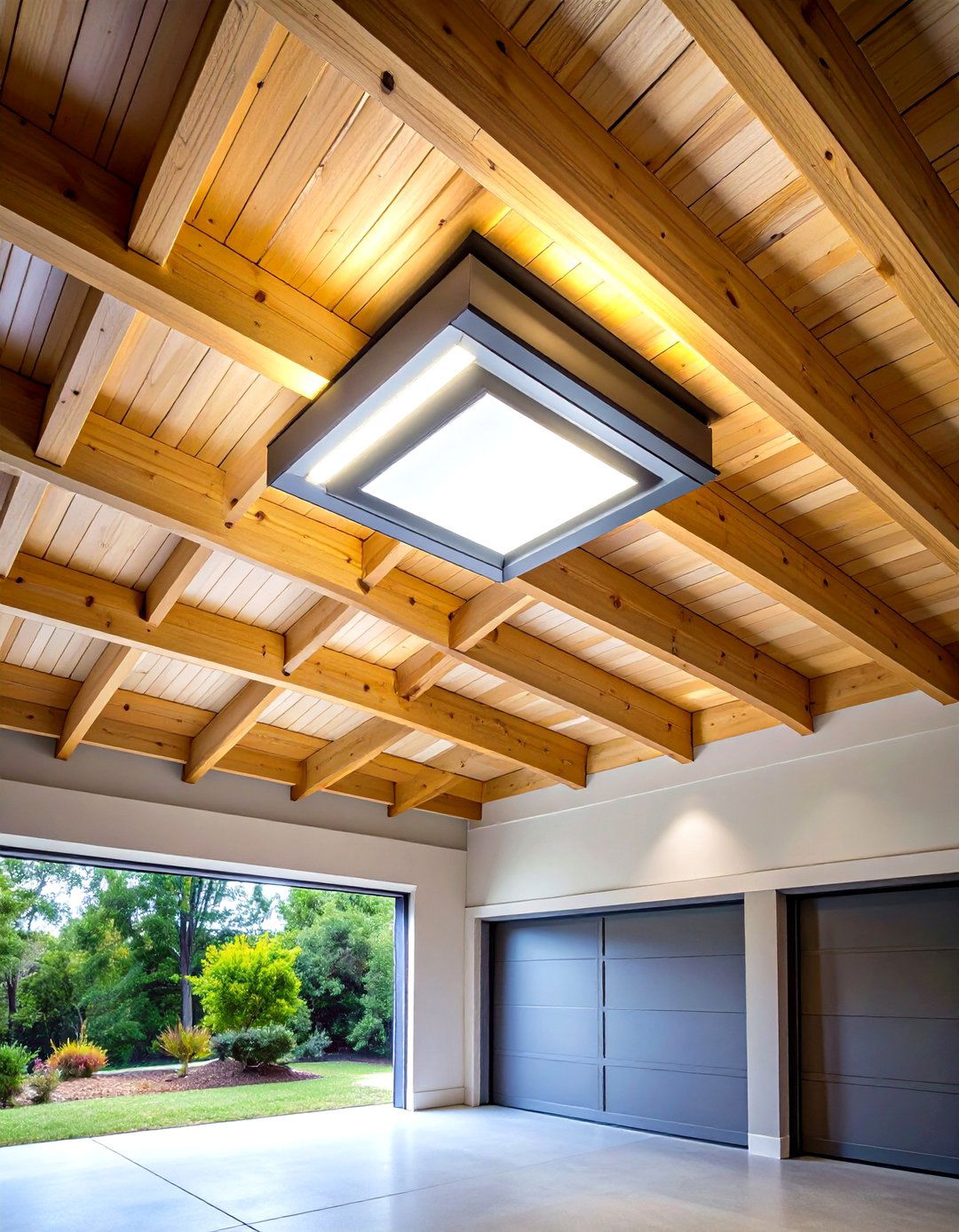
A slim LED wraparound fixed to joists delivers wall-to-wall brightness without hanging chains or bulky housings. Because the diodes line both sides of a wide diffuser, each fixture spreads a uniform sheet of light, reducing shadows that can hide dropped hardware. Modern wraparounds rated around 5,000 K replicate midday daylight and crank out roughly 5,500 lumens while sipping less than 50 watts—nearly 60 percent lower consumption than old fluorescents. Many models plug into a standard outlet, so retrofitting older garages often requires nothing more than two screws and a ladder—no junction-box rewiring.
2. Motion-Activated Overhead Garage Lighting Saves Energy
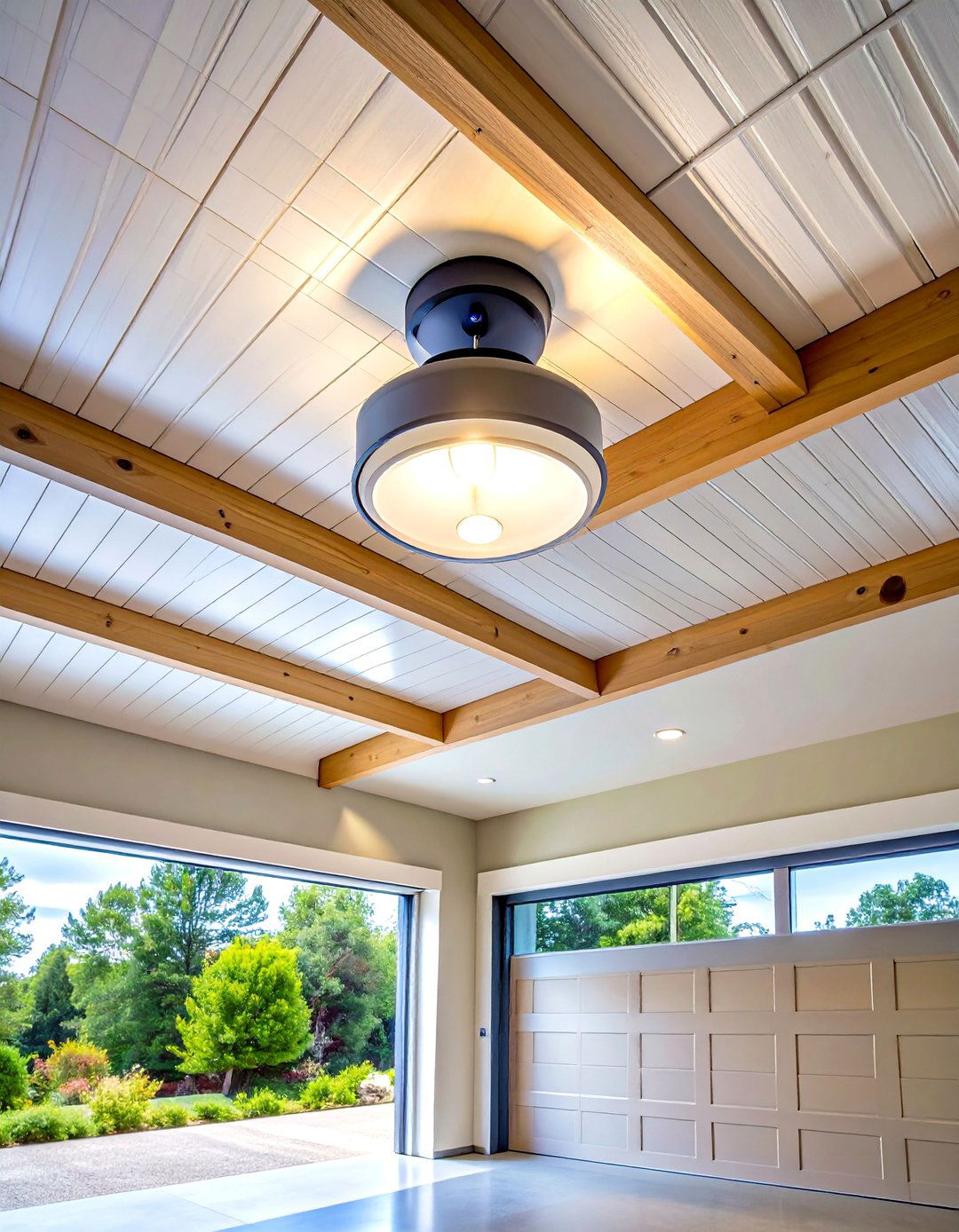
Stepping into a dark bay with full arms often ends in fumbling for switches; a ceiling fixture equipped with microwave or PIR motion sensing springs to life the instant it detects movement within roughly 10 feet. Besides hands-free convenience, occupancy control can trim annual lighting costs by up to 75 percent when the space stands empty most of the day. Seek models with built-in time-delay adjustments, allowing the beams to stay on for 30 seconds to 30 minutes depending on your tasks. Pair multiple sensor fixtures in larger three-car garages for seamless coverage and greater safety during nocturnal tool hunts.
3. Under-Shelf LED Strip Lighting Illuminates Work Surfaces
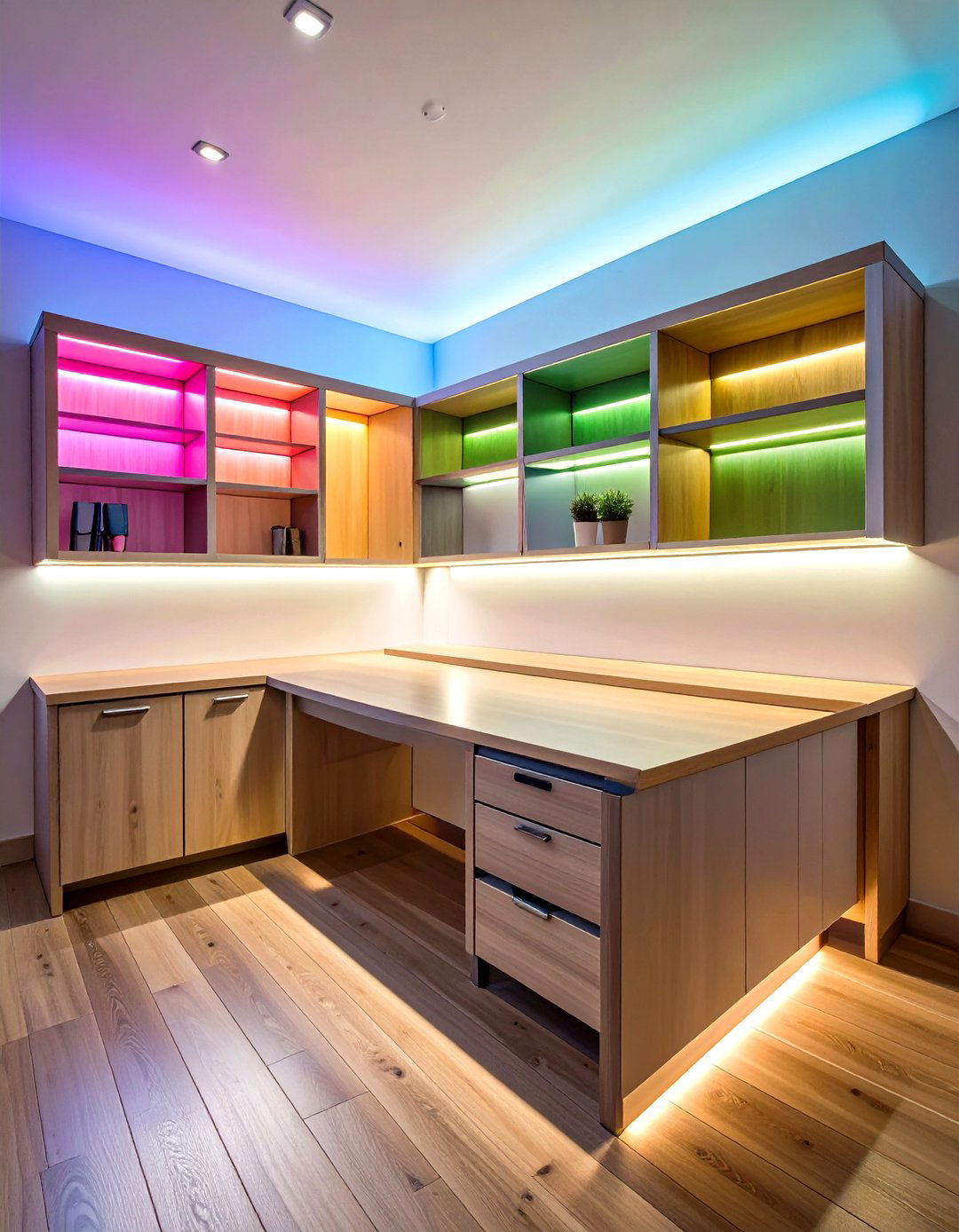
Mounting low-profile LED strips beneath storage shelves or upper cabinets erases the frustrating shadows cast by overhead lights on a workbench. Plug-in bars with integrated diffusers focus 2,000–3,000 lumens directly where bolts and bits land, yet remain barely ⅜ inch thick, so cabinet doors close cleanly. Linkable designs allow several strips to run from a single outlet while retaining individual on-board switches for zoned control. Choose high-CRI (90+) models so paint colors and wiring codes stay accurate, then route cords along shelf backs with adhesive clips to keep the bench clutter-free.
4. High-Bay Shop Lights Tame Tall or Vaulted Ceilings
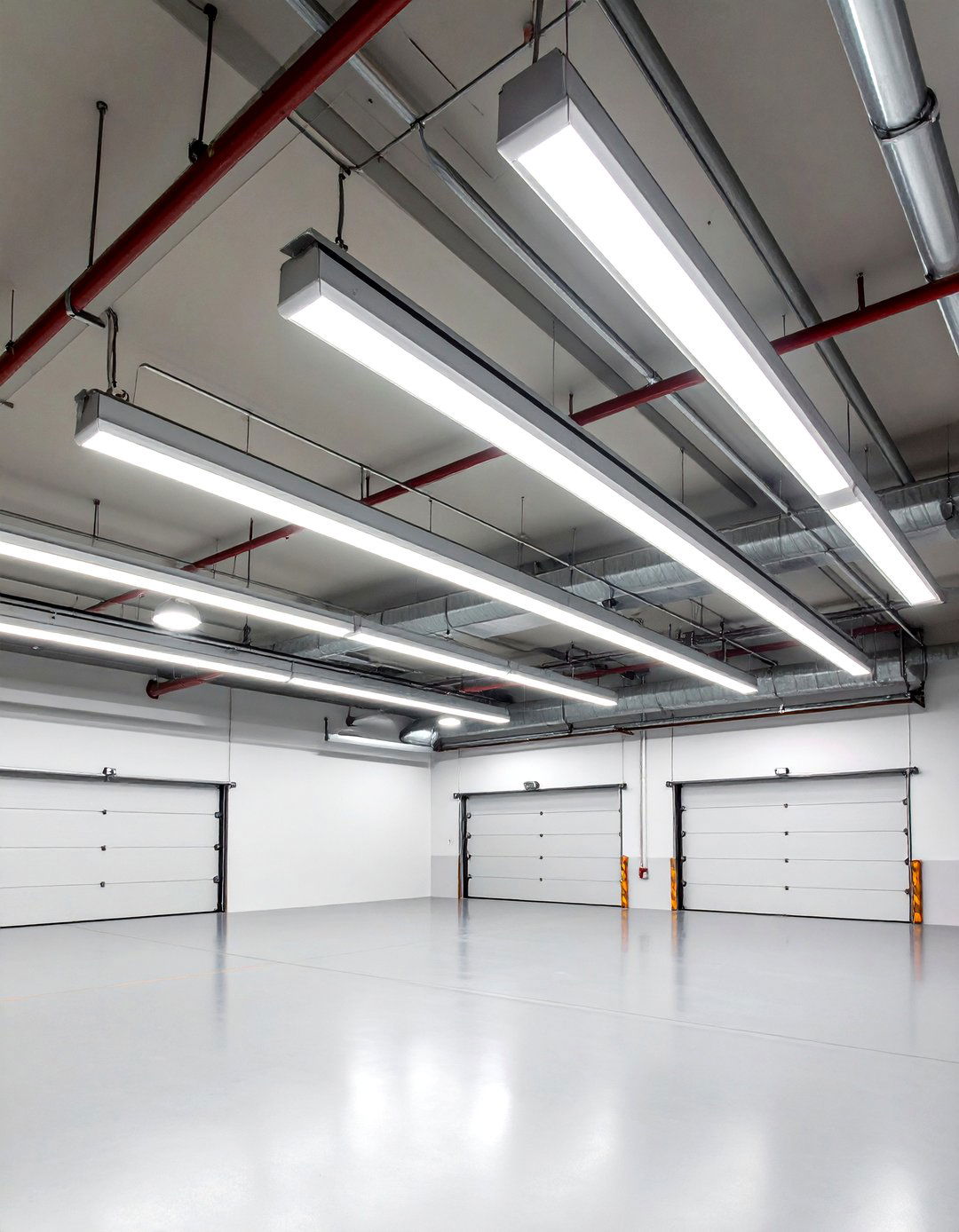
If your garage sports a 12-foot ridge or a car-lift cavity, ordinary bulbs struggle to push adequate lux to the floor. Linear LED high-bay fixtures—originally designed for warehouse aisles—fire 20,000-plus lumens through prismatic lenses, bathing the area below in bright, even light without glare. Look for selectable color-temperature versions (4,000–5,000 K) that adapt to finishing work or casual hobby time. Most hang from simple chain kits and run on common 120 V circuits, making them friendlier for residential retrofits than the ballast-heavy metal-halide lights they replace.
5. Magnetic Rechargeable Task Lights Stick Exactly Where Needed
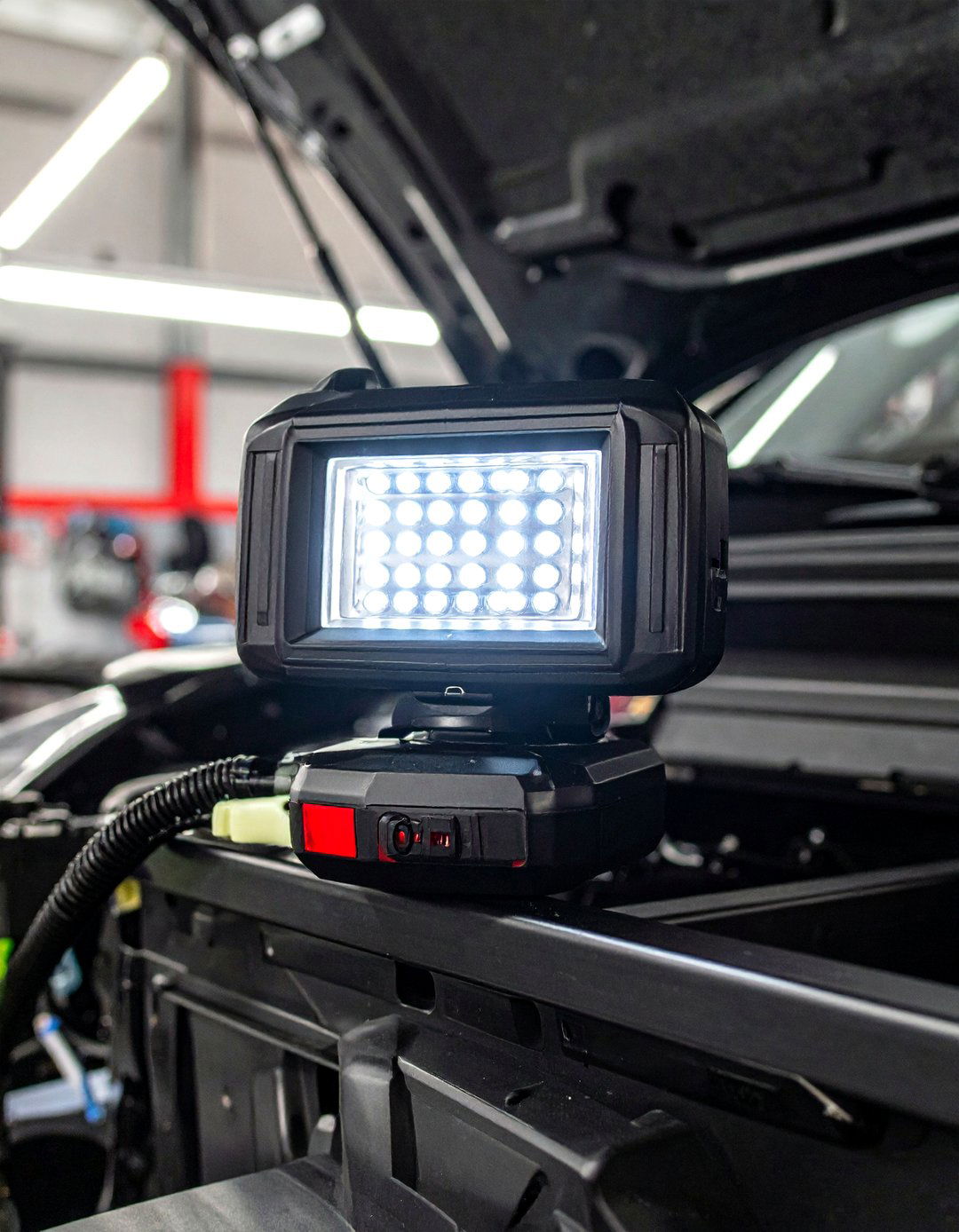
For under-hood tune-ups or brake-job close-ups, a cordless COB-LED light with a robust magnetic base clamps onto fenders, frame rails, or the lift arm—no cords draped across the floor. Compact models fold 360 degrees, push out about 1,200 lumens, and recharge via USB-C so they’re always ready in the top drawer. Keep two on hand: one for illumination, the other as an impromptu inspection mirror by shining across reflective metal. Because LEDs run cool, there’s minimal risk of melting trim or scorching paint if you accidentally bump the housing.
6. Color-Temperature-Tunable Bulbs Adapt Garage Lighting Mood
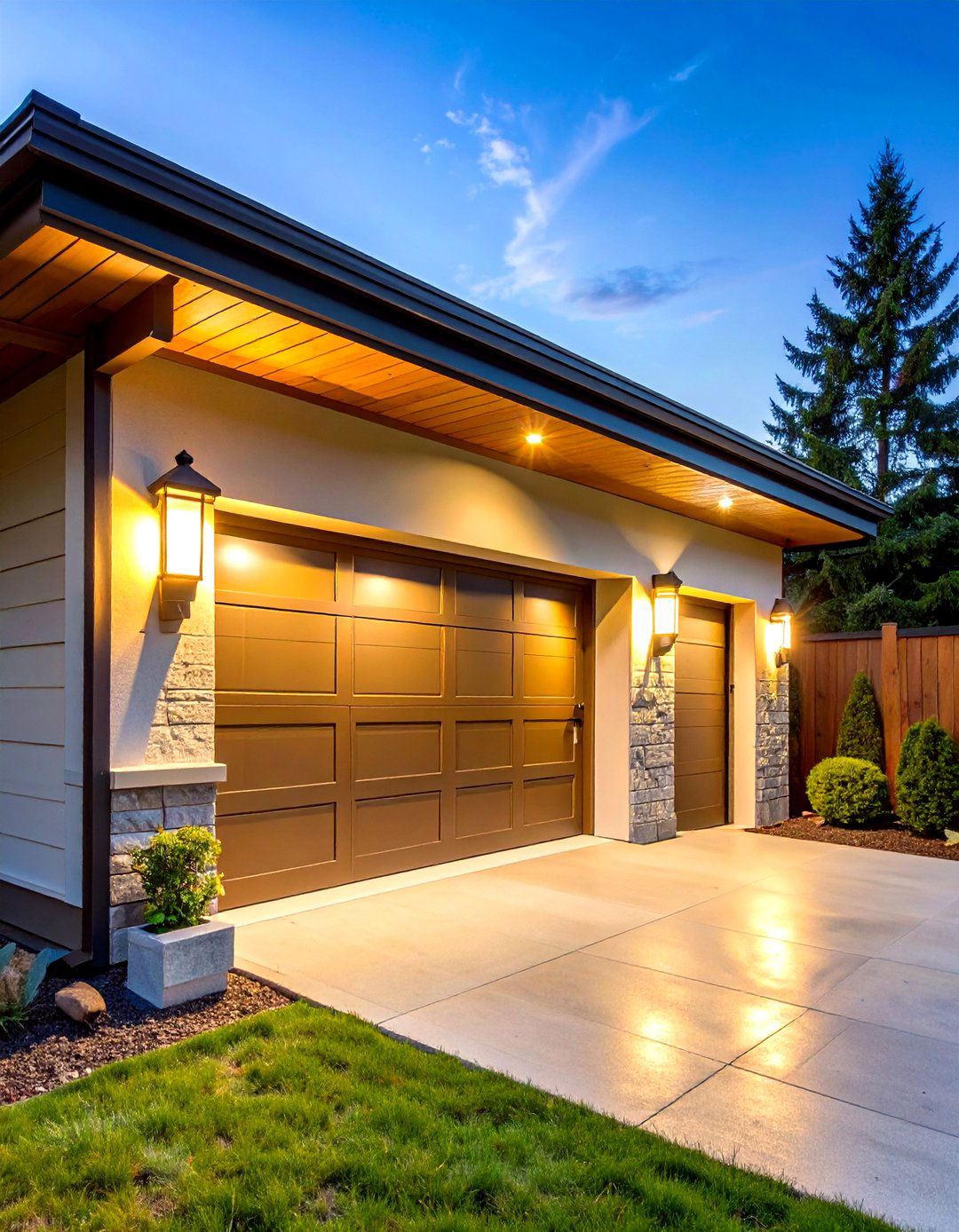
Screw-in LED bulbs that cycle from warm 2,700 K to crisp 5,000 K let you shift the bay’s vibe from cozy project lounge to daylight-bright detailing studio with a tap of a remote. Adjustable output also cuts eye strain; use softer white for late-night organizing sessions and daylight for precision cutting. Since the tuning occurs within the bulb, installation is identical to a traditional A-21 lamp—perfect for single-socket garage door-opener heads that need a brightness upgrade without rewiring.
7. Articulated Workbench Lamps Deliver Pin-Point Garage Lighting

A swing-arm desk lamp clamped to a bench rail travels up, down, and sideways, throwing focused light exactly where drill bits meet metal. Opt for units with interchangeable flood and spot reflectors plus on-board dimming; an 800-lumen flood gently washes a large assembly, while a 400-lumen spot zeroes in on solder joints. A spring-balanced arm holds position without droop even after thousands of adjustments, and the lamp’s small footprint leaves prime bench real estate free for parts trays.
8. Wall-Mounted Uplights Add Ambient Glow and Safety
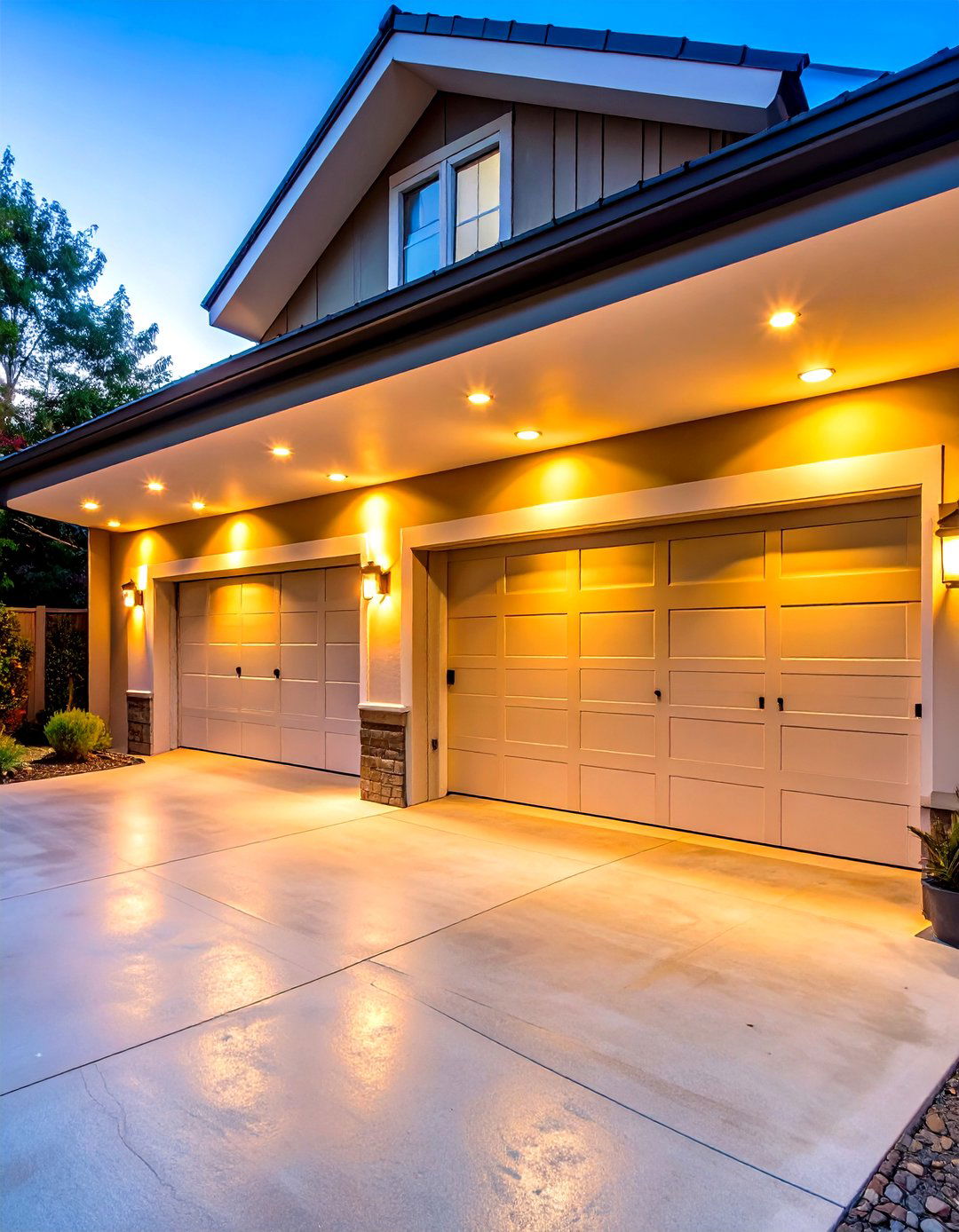
Installing slim LED bars midway up sidewalls bounces light off white sheetrock, filling the garage with soft, shadow-free ambient illumination ideal for social gatherings or yoga sessions when the cars roll out. Sidewall lighting also eliminates harsh contrasts at floor level, making spilled oil or trip hazards easier to spot. Because the luminaires mount above bumper height, they’re safe from door dings, and many dim to 10 percent for mood lighting while still acting as a gentle night-light when returning home.
9. Parking-Assist Laser Lights Prevent Fender Bumps
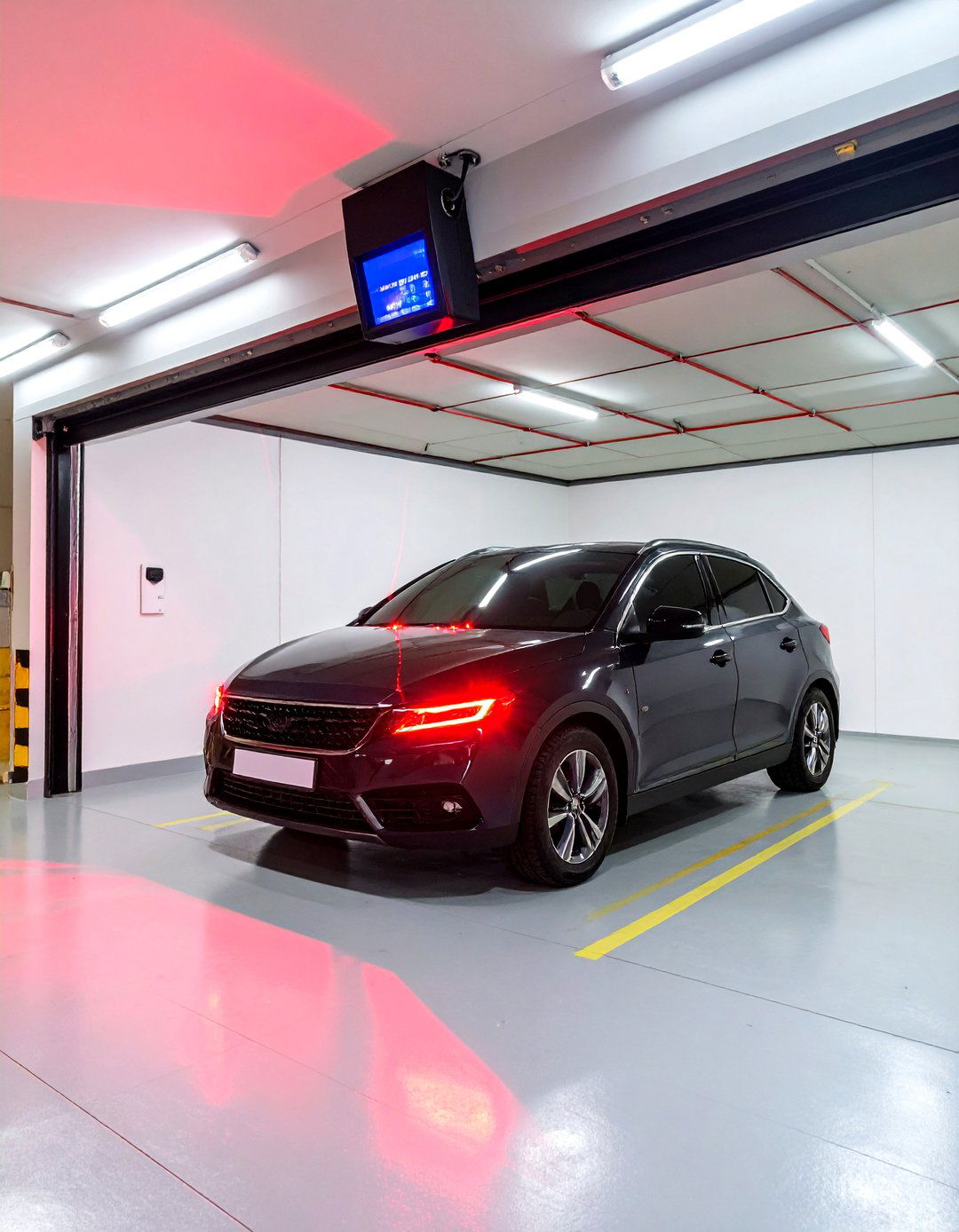
Dual-beam laser guides mount near the opener and project thin red dots onto a windshield or dash, signaling when to brake precisely in tight garages. Motion sensors trigger only when a vehicle pulls in, drawing negligible power the rest of the day. Unlike hanging tennis balls, lasers never tangle with roof racks, and beam positions adjust via simple thumbscrews to fit sedans or SUVs. Pair them with overhead LEDs so the bay brightens simultaneously, creating a seamless, high-tech parking routine.
10. Tubular Skylights Flood the Garage With Free Daylight
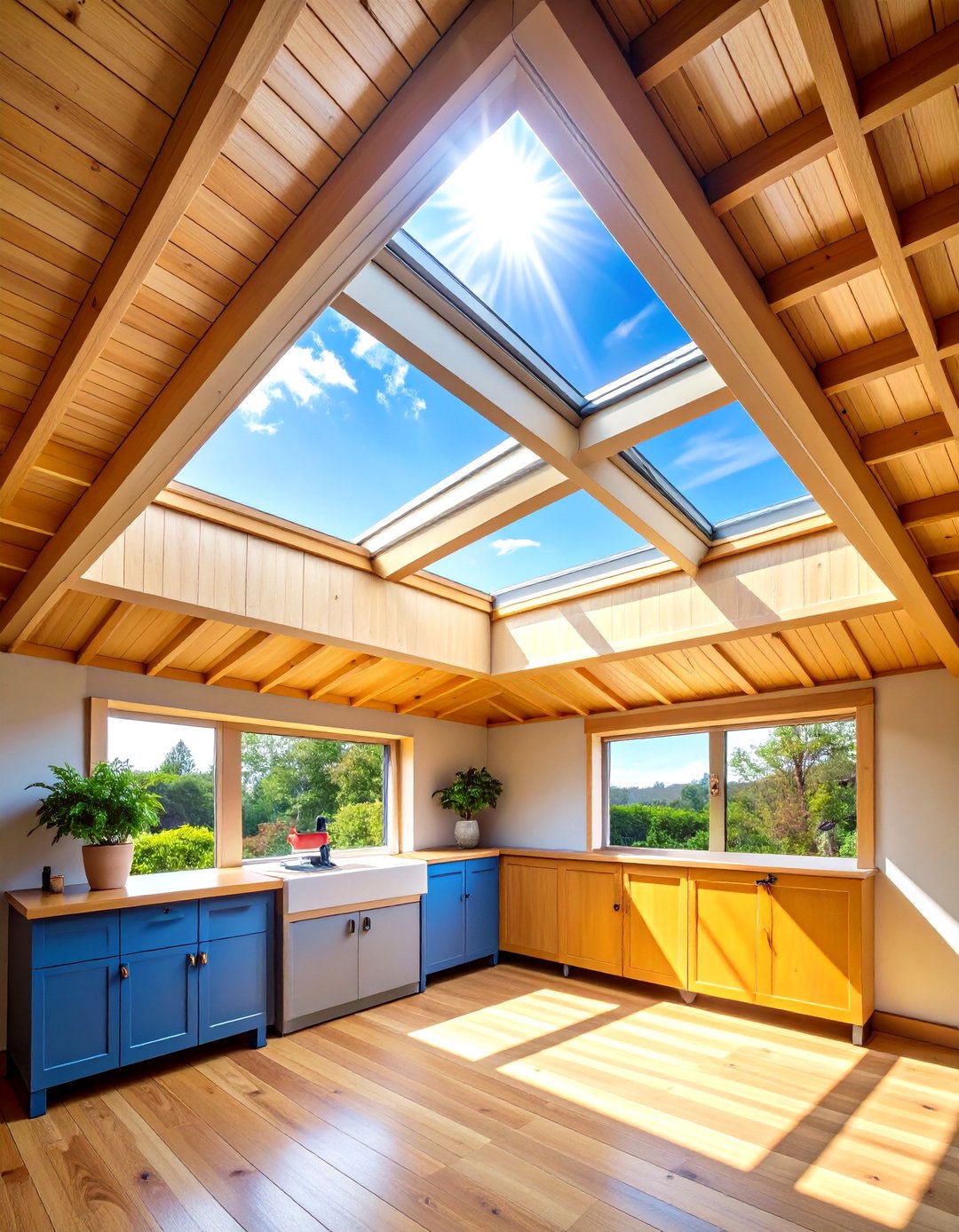
A 10-inch diameter solar tube funnels sunshine through a reflective duct, pouring the equivalent of a 300-watt bulb onto your bench—yet burns zero electricity. Diffusers filter harmful UV, protecting finishes, and optional dimmer lenses let you dial back intensity on blazing afternoons. Because the tube snakes between rafters, installation often avoids structural changes. Pair daylighting with occupancy-sensor LEDs so artificial lighting kicks on automatically when clouds roll in, maintaining consistent illumination all day.
11. Solar-Powered Security Lights Guard the Exterior Entry

Weather-sealed LED floodlights with onboard photovoltaic panels mount above the garage door and charge during daylight, then blast 2,500-plus lumens across the driveway when motion trips their sensors. Look for multi-head models offering 270-degree coverage so approaching foot traffic or wildlife can’t hide in shadows. Because the fixtures operate off their own battery, they spare you from fishing wires through stucco or brick, making them a weekend win for renters and homeowners alike.
12. Low-Level Rope Lights Mark Safe Night-Time Pathways
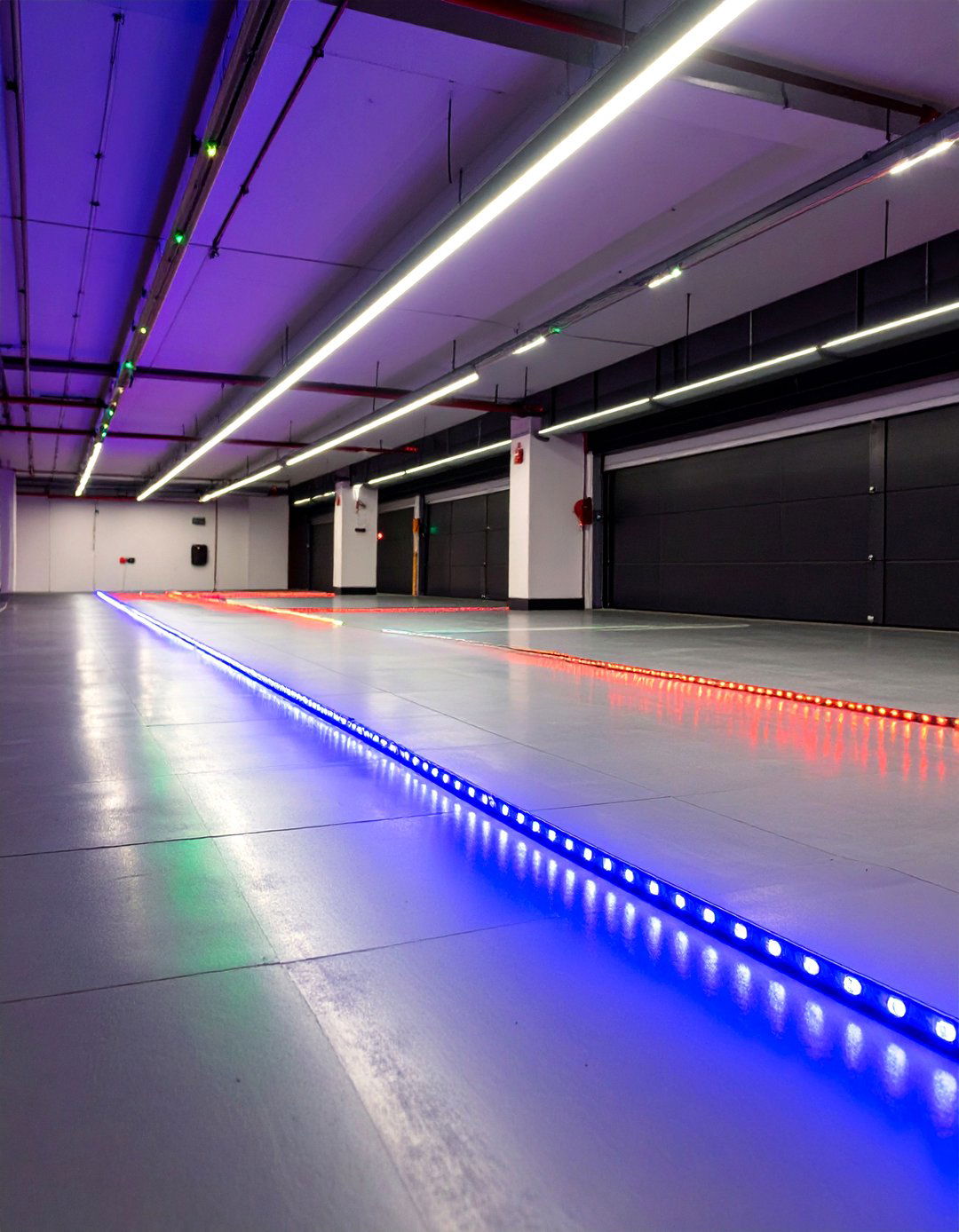
Running LED rope or strip lighting along the floor’s perimeter within four inches of the wall meets many egress demarcation guidelines and keeps sleepy eyes oriented during a midnight fridge raid. Choose durable IP65 tubing rated to resist tire impact and occasional sweeping. Soft, indirect glow at ankle height preserves night vision yet highlights bicycles, storage totes, and step-ups, helping prevent stumbles without the glare of full overhead lights.
13. Vintage-Style Pendant Garage Lighting Adds Character

Swapping one or two sockets for metal-shaded pendants fitted with LED Edison filaments dresses up a garage converted to a home gym or rehearsal studio while still punching out 1,000-plus lumens per lamp. Hang pendants eight feet above the floor to clear hatchbacks, and pair them with a dimmer for flexible ambience. Vintage fixtures also direct light downward, leaving ceiling areas darker to accent reclaimed-wood beams or exposed trusses for an industrial vibe.
14. Battery-Backed Emergency Lights Ensure Code-Compliant Egress
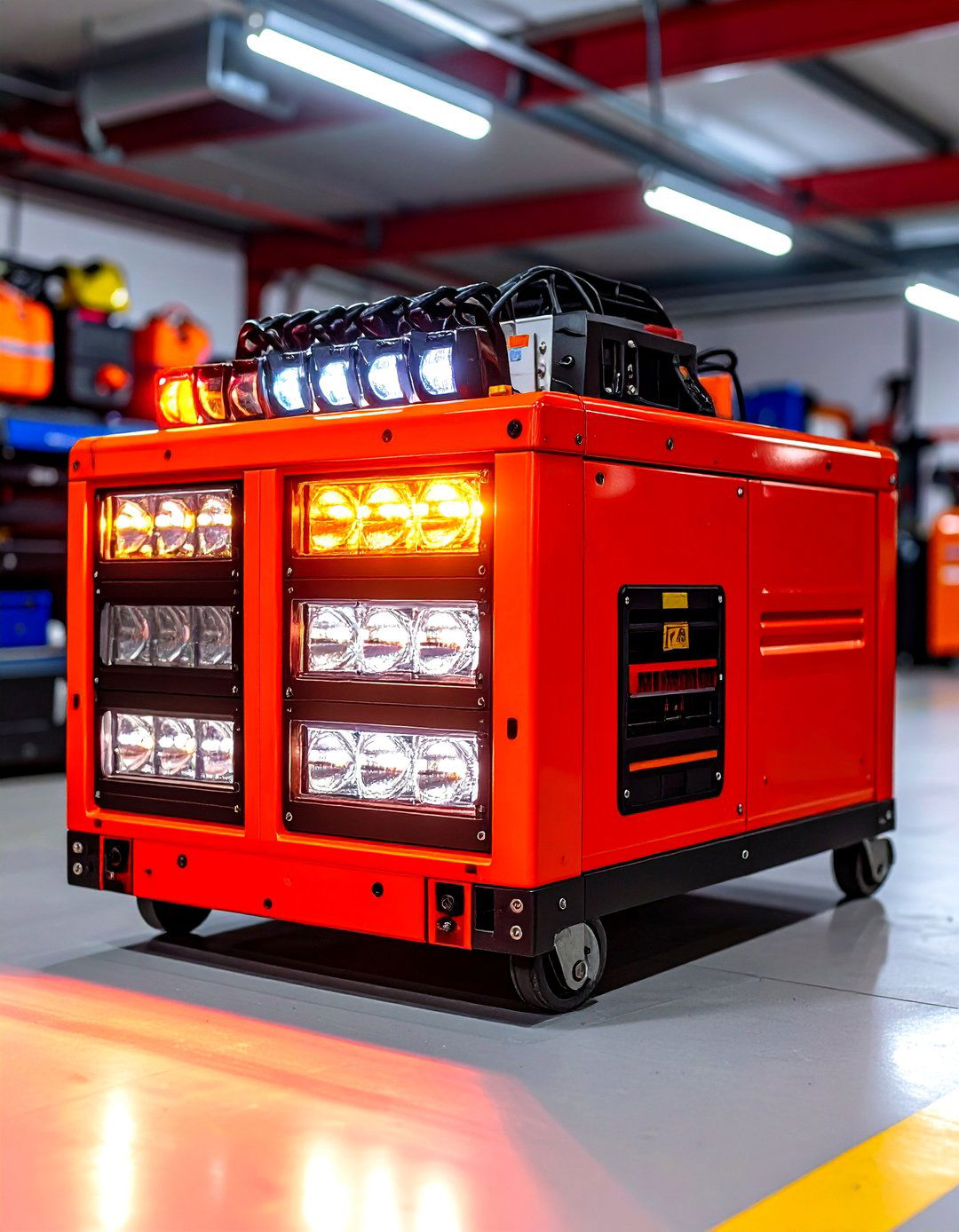
A combination LED emergency unit with two adjustable heads and an internal lithium battery mounts above the side door, automatically staying lit for at least 90 minutes during an outage—meeting Life-Safety-Code requirements. Some models incorporate self-test indicators that flash monthly, so you’ll know when replacement is due long before failing a safety inspection. In daily use, the fixture doubles as a night-light at 10 percent output, eliminating the need for separate pathway lighting.
15. Bluetooth-Speaker Bulbs Turn Wrenching Into a Soundtrack
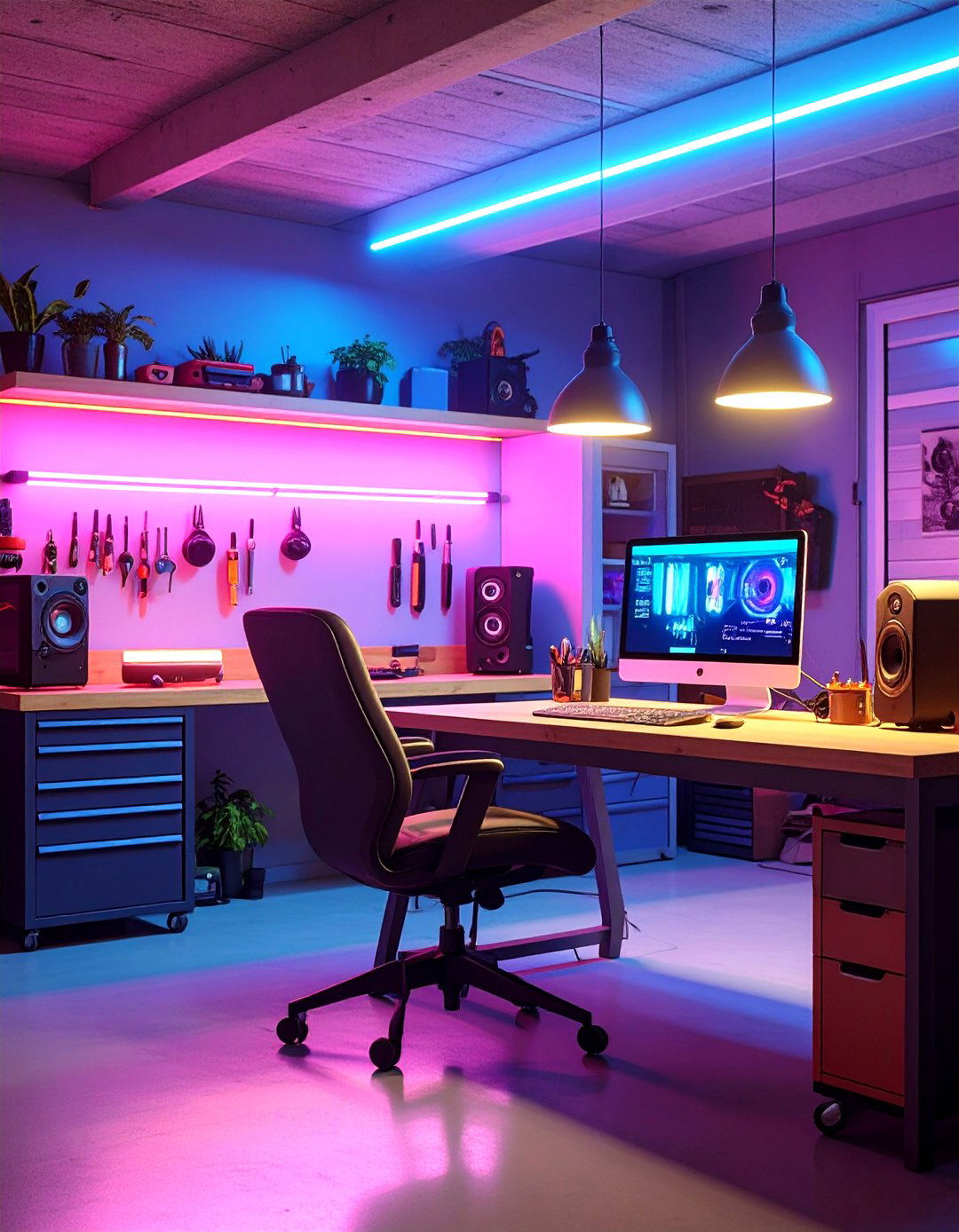
LED garage-lighting bulbs with built-in Bluetooth speakers beam 3,500-plus lumens while streaming podcasts or playlists straight from a phone—perfect for solo tune-ups. Since audio and illumination share the same E26 base, installation takes seconds, and many units include remote control for volume and track skips. Position two bulbs in opposite corners for stereo separation without sacrificing precious outlet space to standalone speakers or chargers.
16. Ceiling-Fan-Light Combos Keep Workshops Cool and Bright
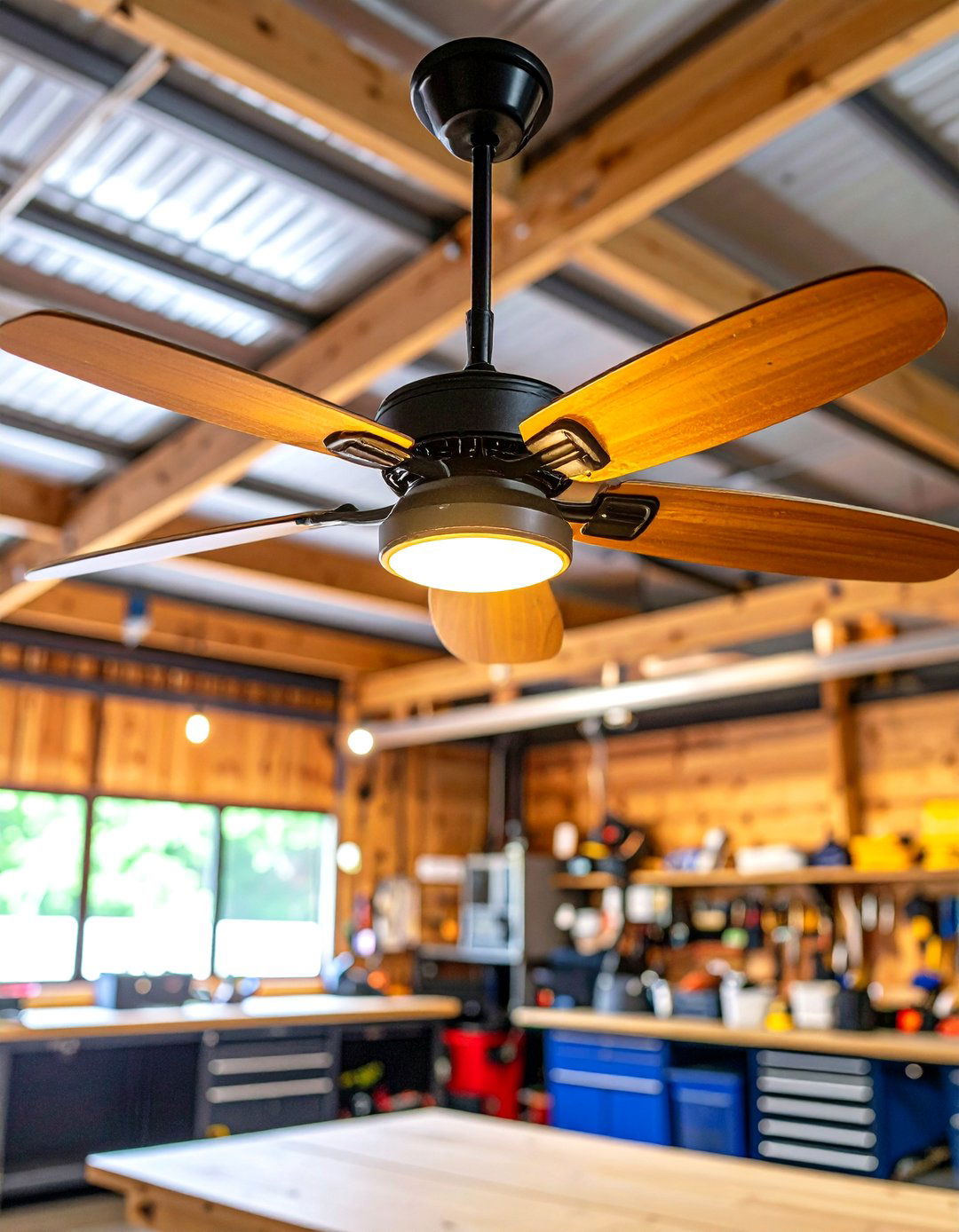
An integrated LED ceiling fan rated for damp locations circulates air to dispel sawdust and solvent fumes while throwing 4,000-plus lumens of neutral white light. Color-changing models switch to soft amber for relaxed cleanup sessions, and reversible blades push warm air downward in winter. Remote-controlled speed eliminates climbing ladders to change settings, a boon when your hands are coated in finish or grease.
17. UV-Cure Task Lamps Speed Paint and Resin Projects
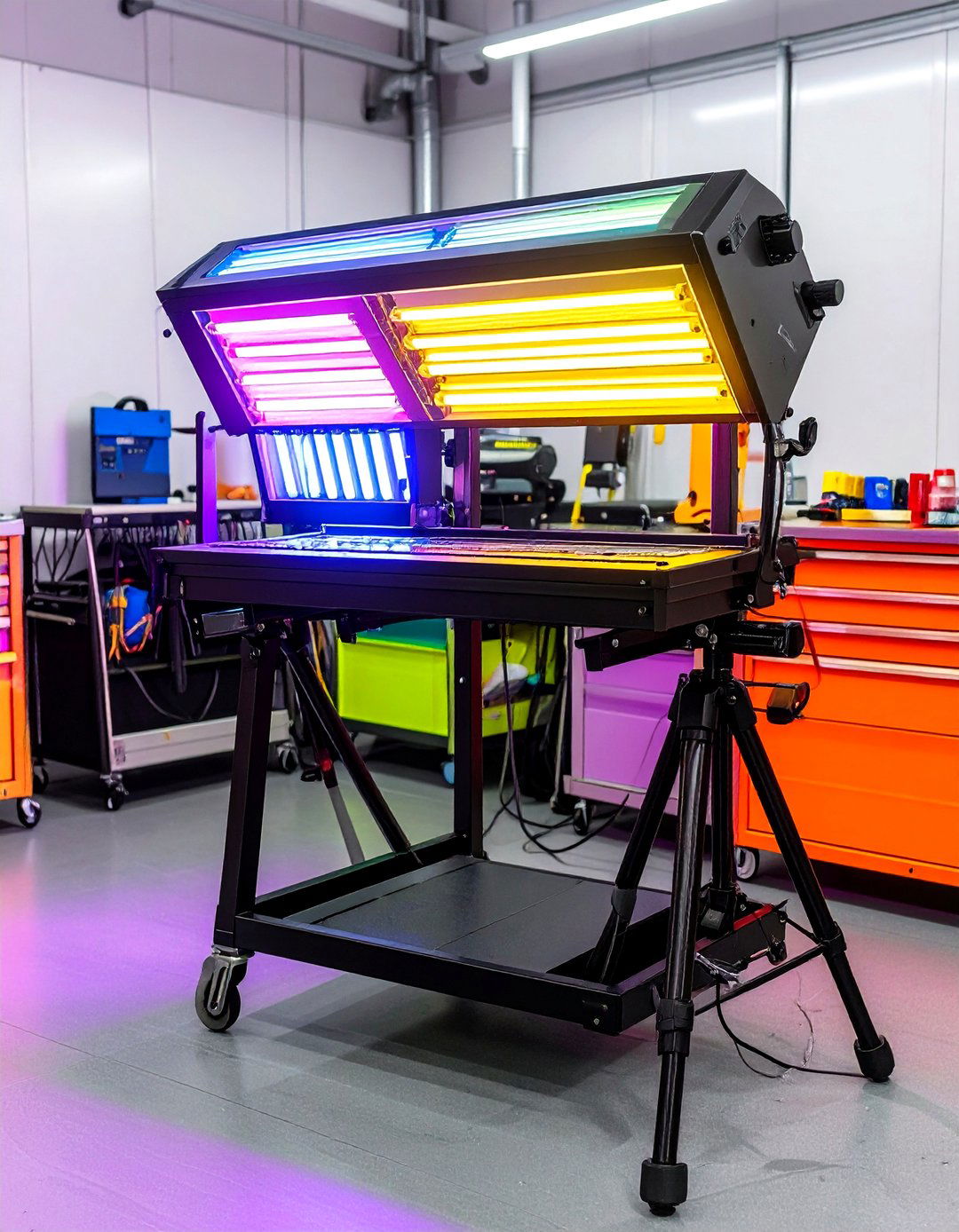
Portable infrared or ultraviolet curing lamps designed for auto-body work harden touch-up clear coats or epoxy in minutes, slashing wait times between coats and freeing the bay sooner. Adjustable tripod stands angle the head precisely, and dual-spectrum fixtures let you toggle between UV for accelerated curing and IR for gentle heat on plastic panels. Always follow manufacturer eye-protection recommendations when adding UV technology to your garage-lighting arsenal.
18. Recessed Downlights Offer Sleek, Shadow-Free Garage Lighting
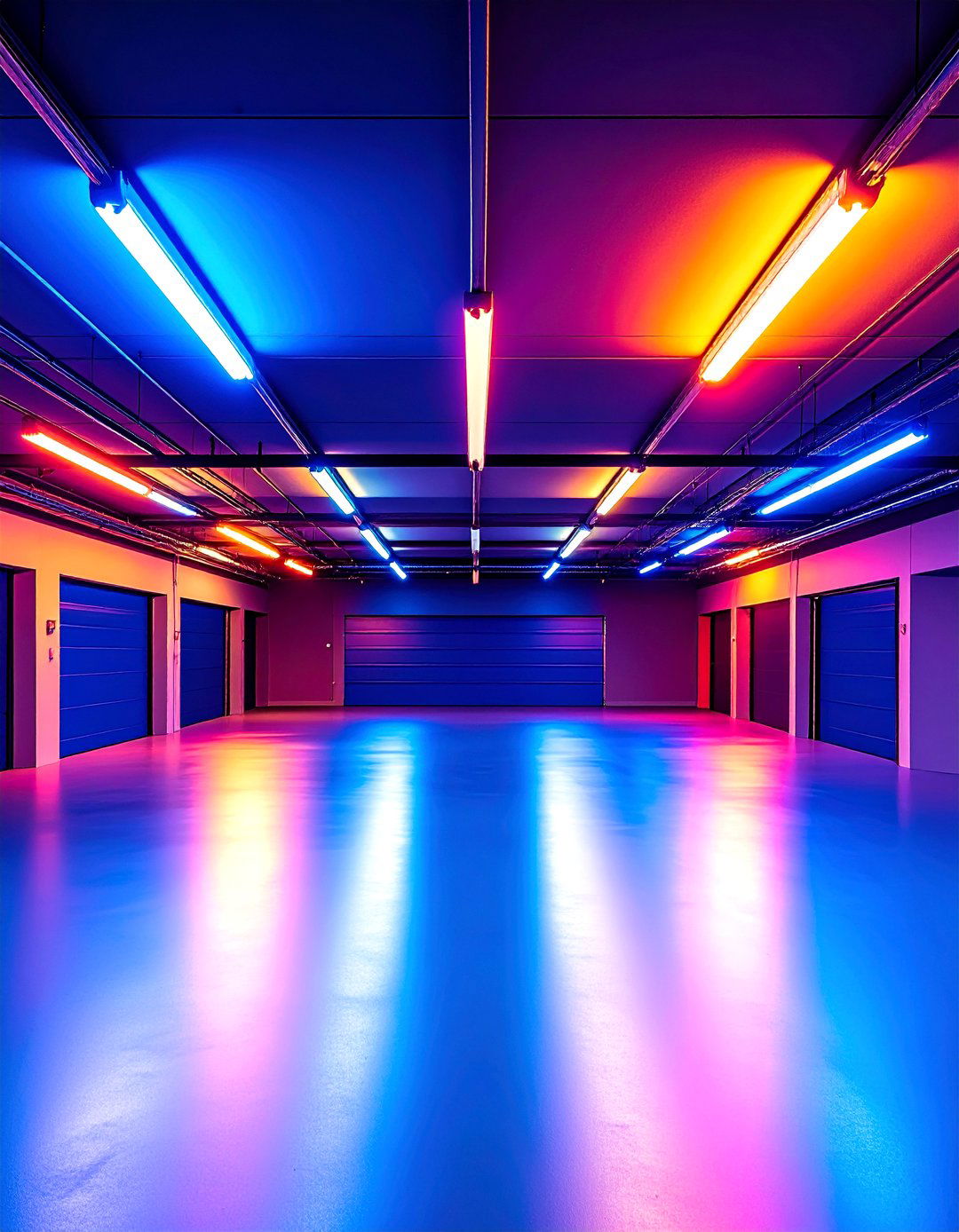
IC-rated LED can lights recessed between joists keep ceilings uncluttered while providing targeted task beams. Follow the ceiling-height-divided-by-two spacing rule—about four feet apart for an eight-foot ceiling—to avoid dark scallops. Use wet-location trims near garage-door tracks where wind-driven moisture can intrude. Dimmable drivers pair nicely with smart switches for multi-level control, letting bright illumination for detailing ramp down to a soft glow for movie-night projector setups.
19. DIY PVC LED Light Bars Deliver Custom Coverage on a Budget
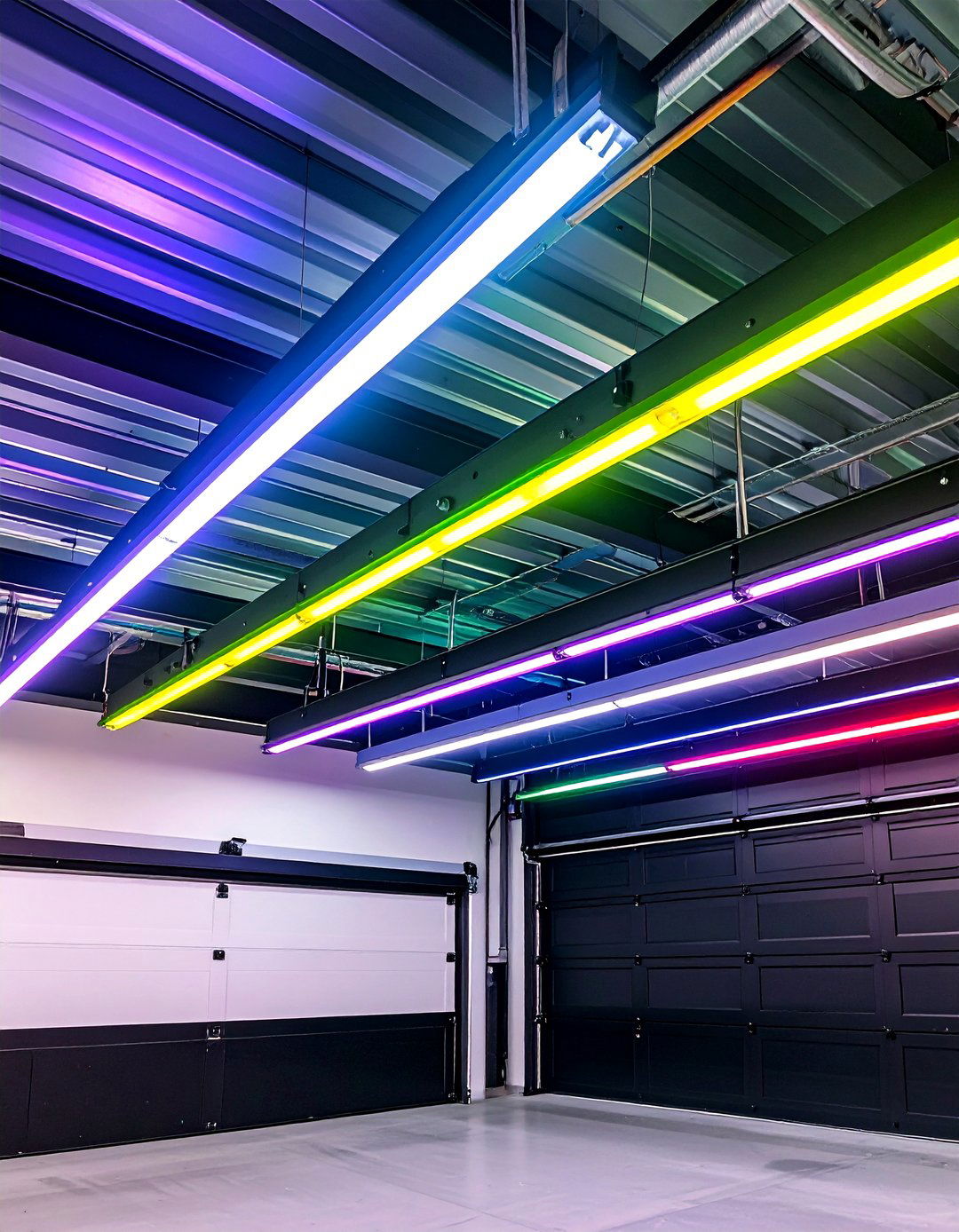
Building light bars by threading LED strips inside painted PVC conduit creates rigid, lightweight fixtures that screw directly to rafters, offering continuous illumination across the entire ceiling span. Reflective interior tape boosts output, and translucent diffusers cut glare. By linking multiple bars to a single 12-V DC power supply, hobbyists gain modular flexibility—swap a single strip when it fails instead of replacing an entire fixture.
20. Smart Scenes Tie Garage Lighting to Voice and Sensors

Combining a wireless occupancy sensor with app-controlled switches lets you trigger preset “Arrive,” “Work,” or “Close-Up” scenes by voice command or motion. For example, walking through the interior door after dusk can fade in overhead LEDs to 80 percent, spotlight the bench at 100 percent, and start soft rope lighting around the perimeter—all without touching a switch. Automation not only feels futuristic; it also extends lamp life by ensuring lights shut off when the last person leaves.
Conclusion:
Adopting thoughtful garage lighting means pairing the right output, placement, and control to every task—whether that’s precision wrenching under a high-bay beam, parking with laser accuracy, or simply finding your way to stored sports gear during a blackout. LED technology, motion sensors, and smart integrations now make it easier and more economical than ever to create a space that’s brighter, safer, and more enjoyable every day you pull up the door.


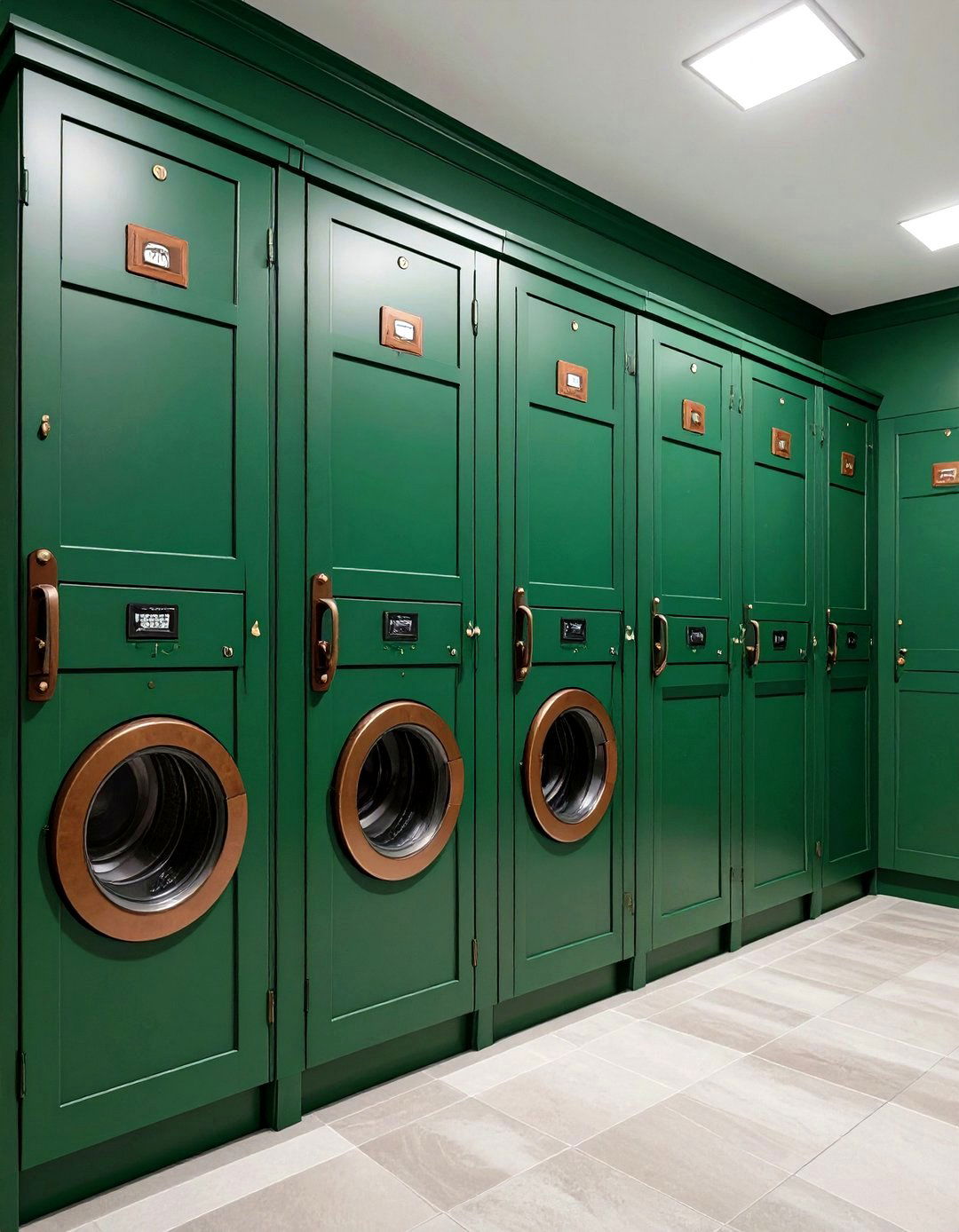

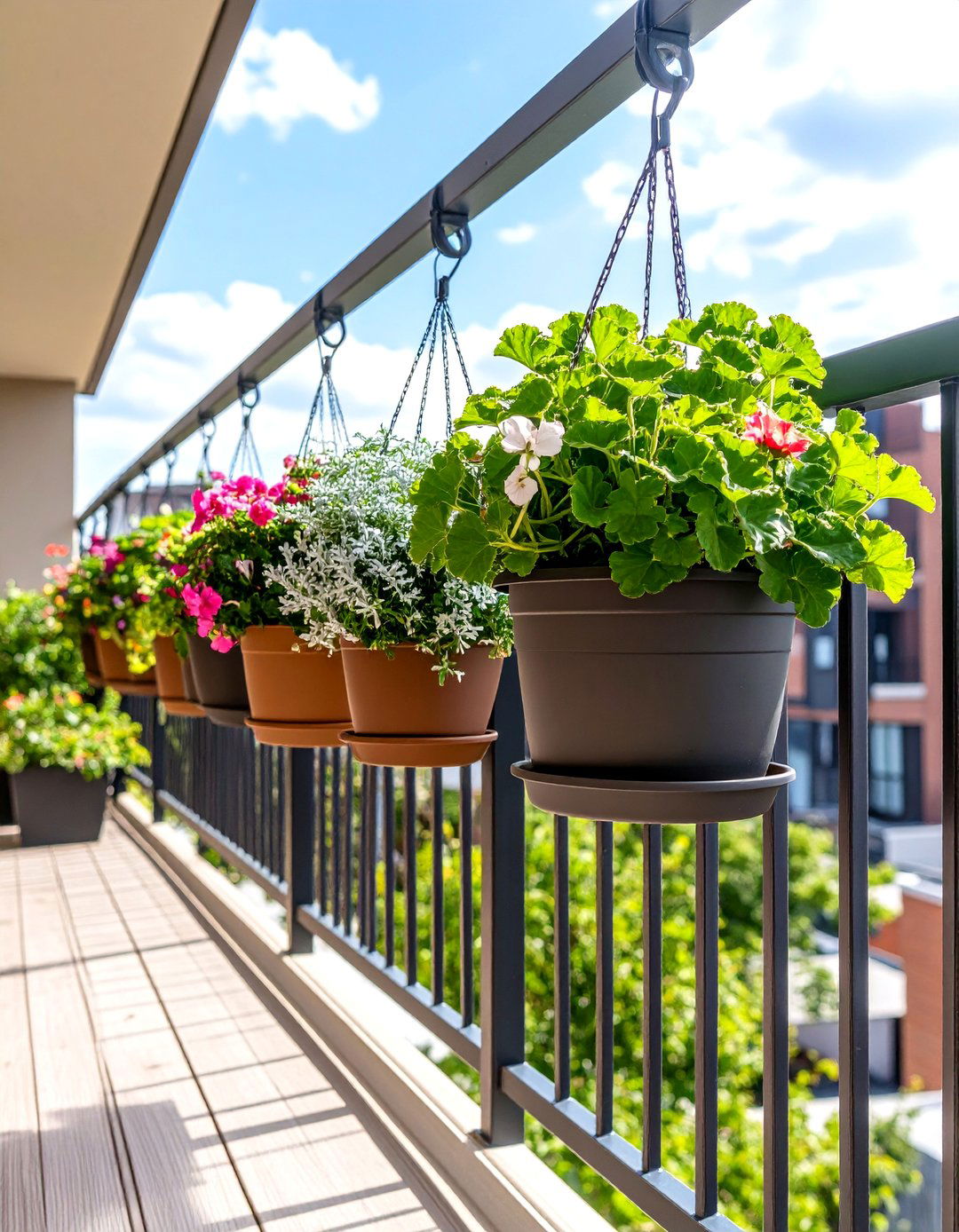
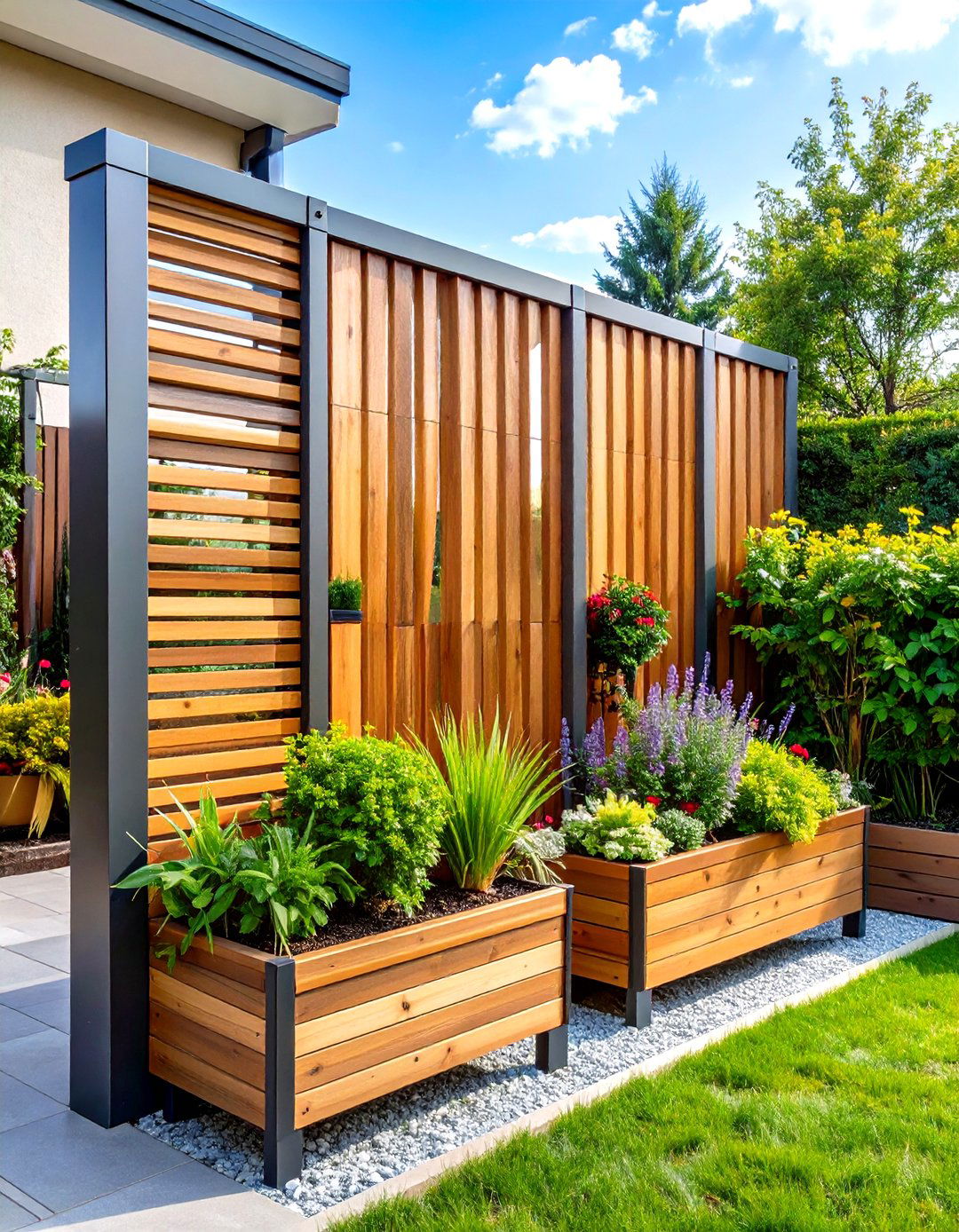
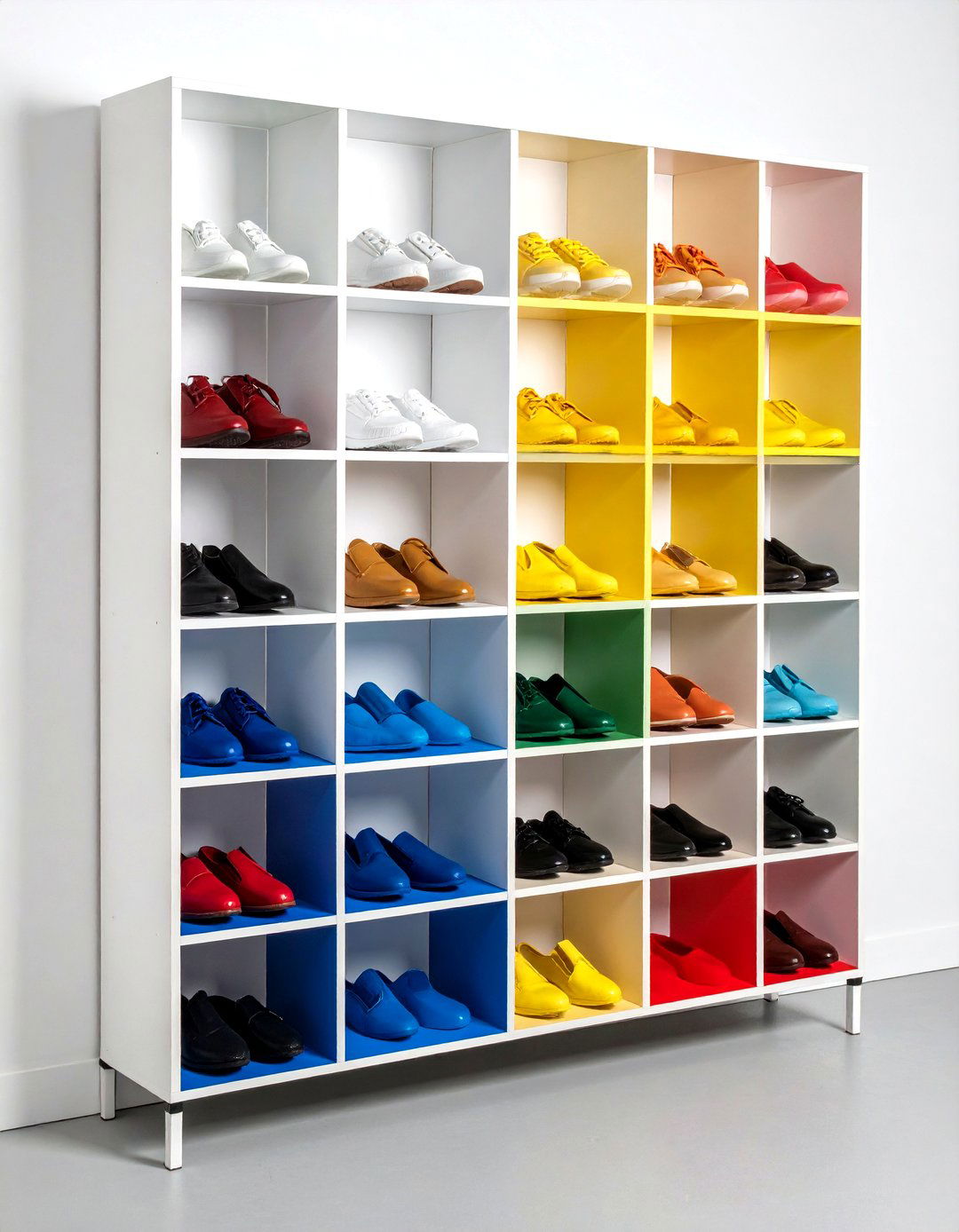
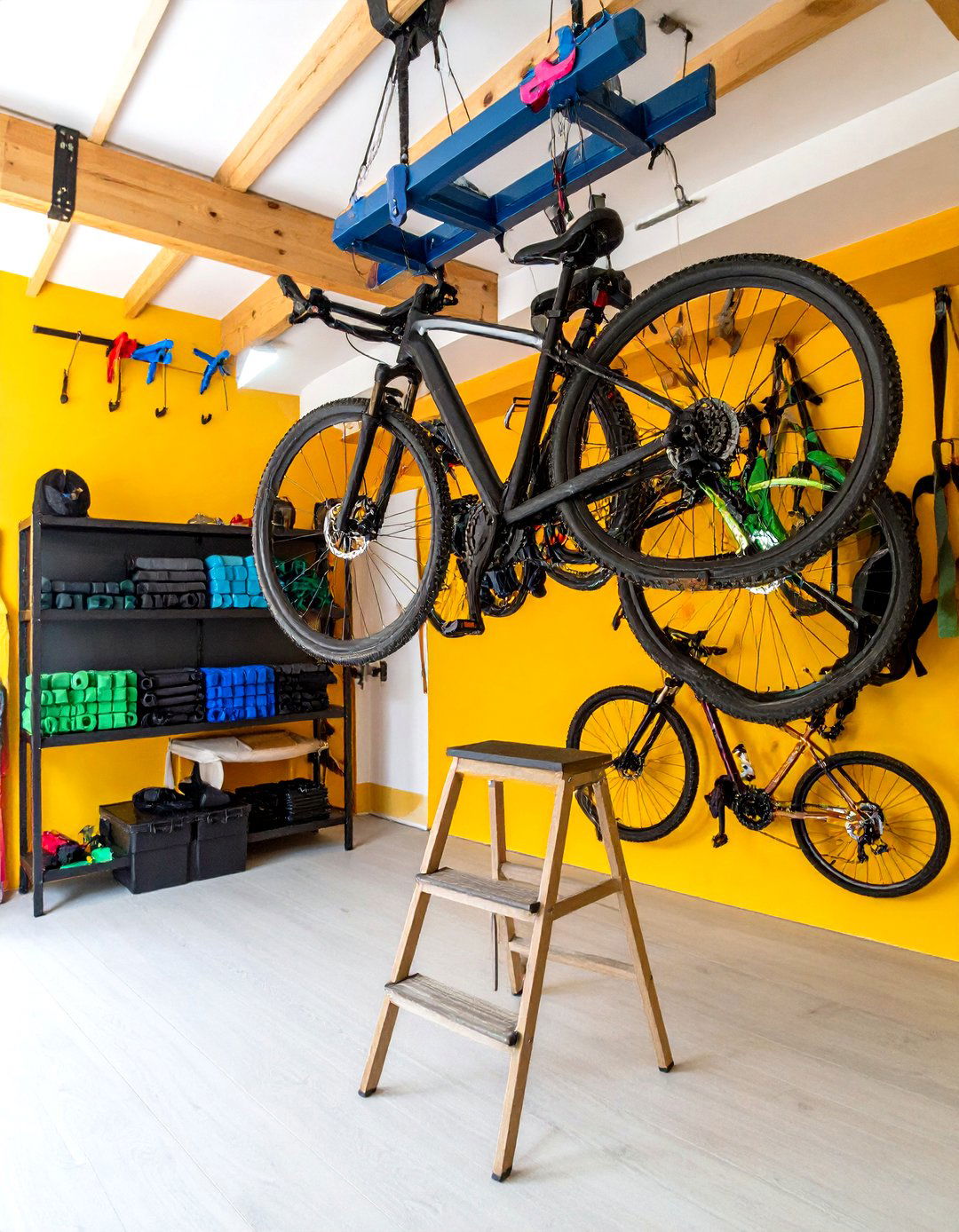


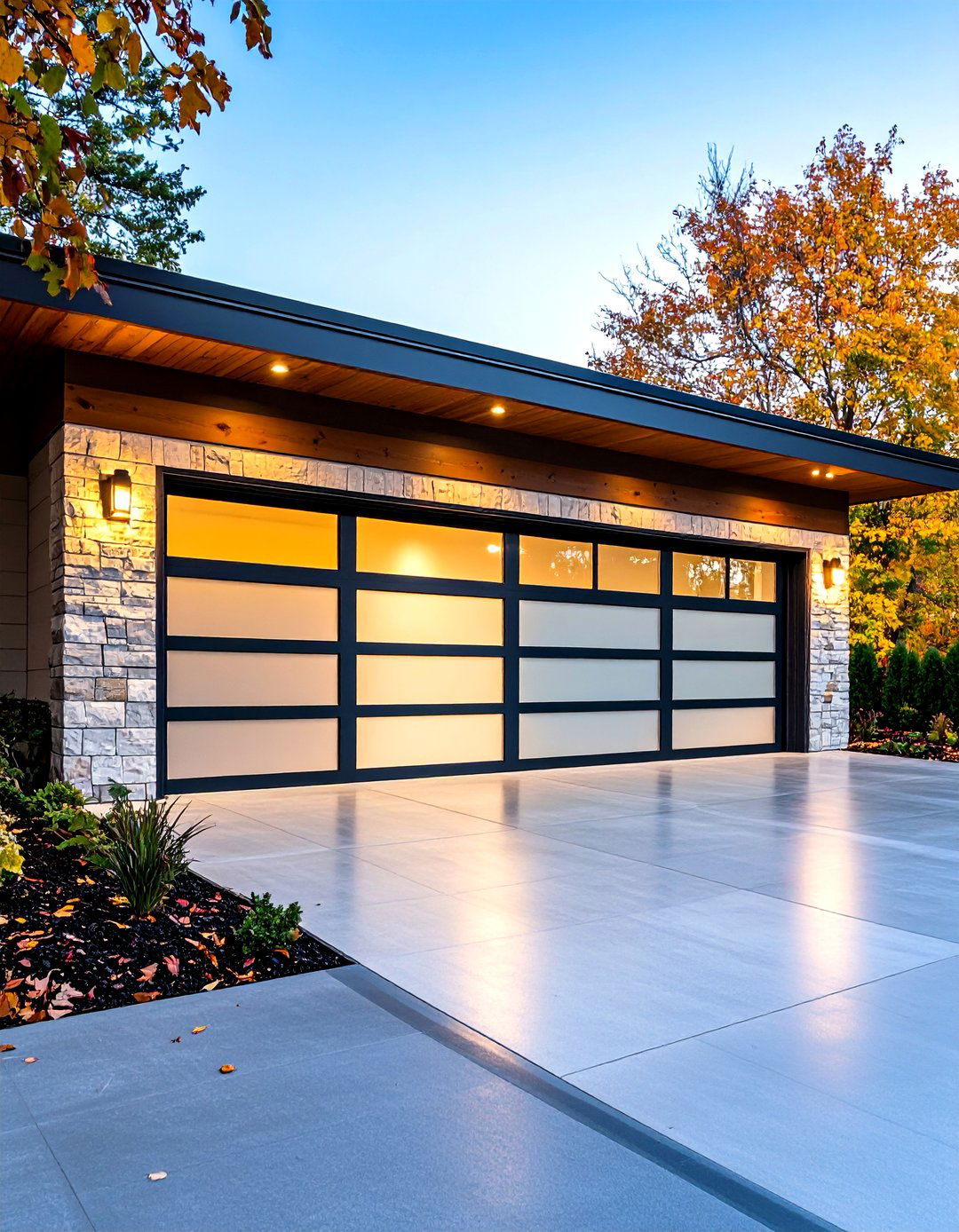
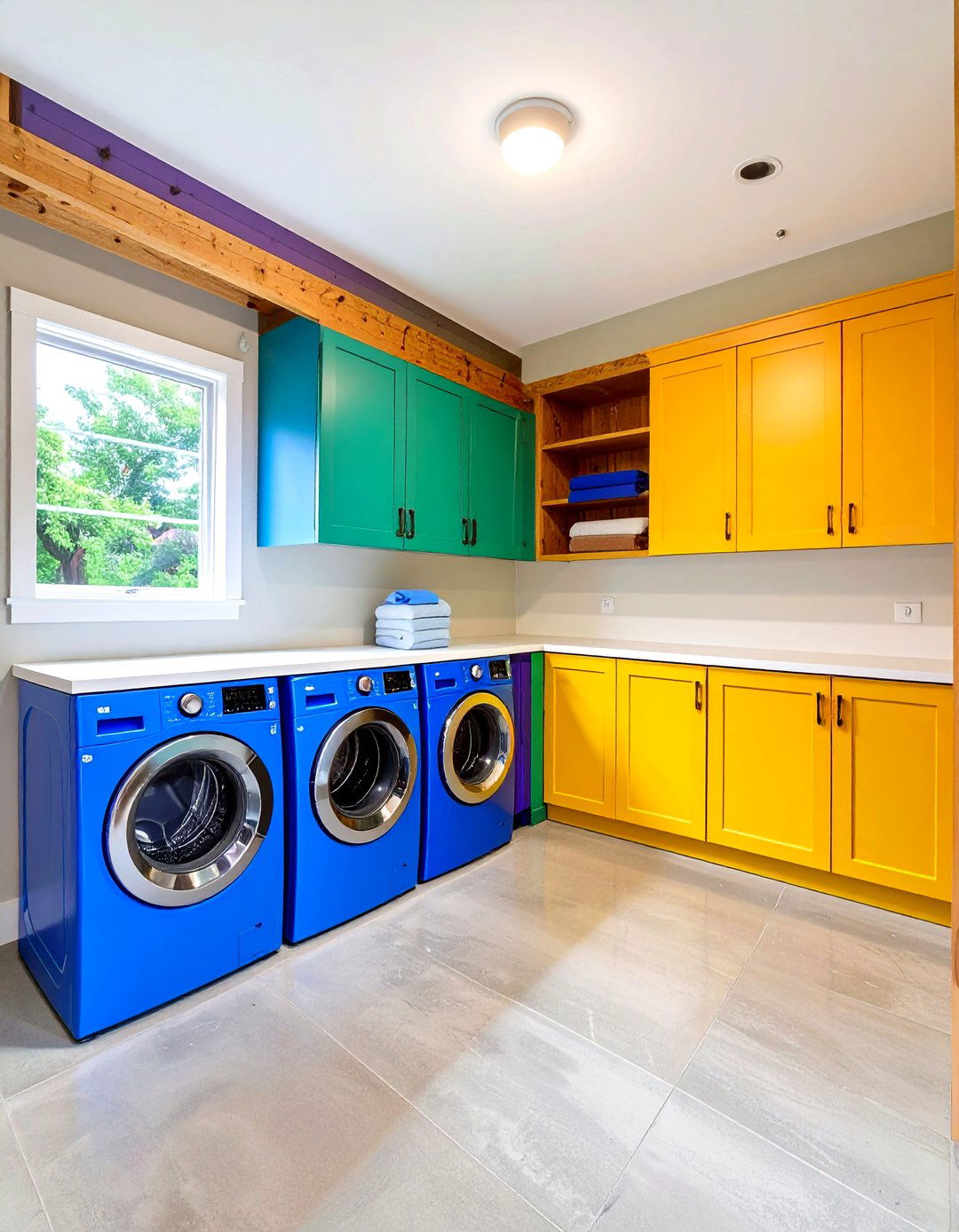
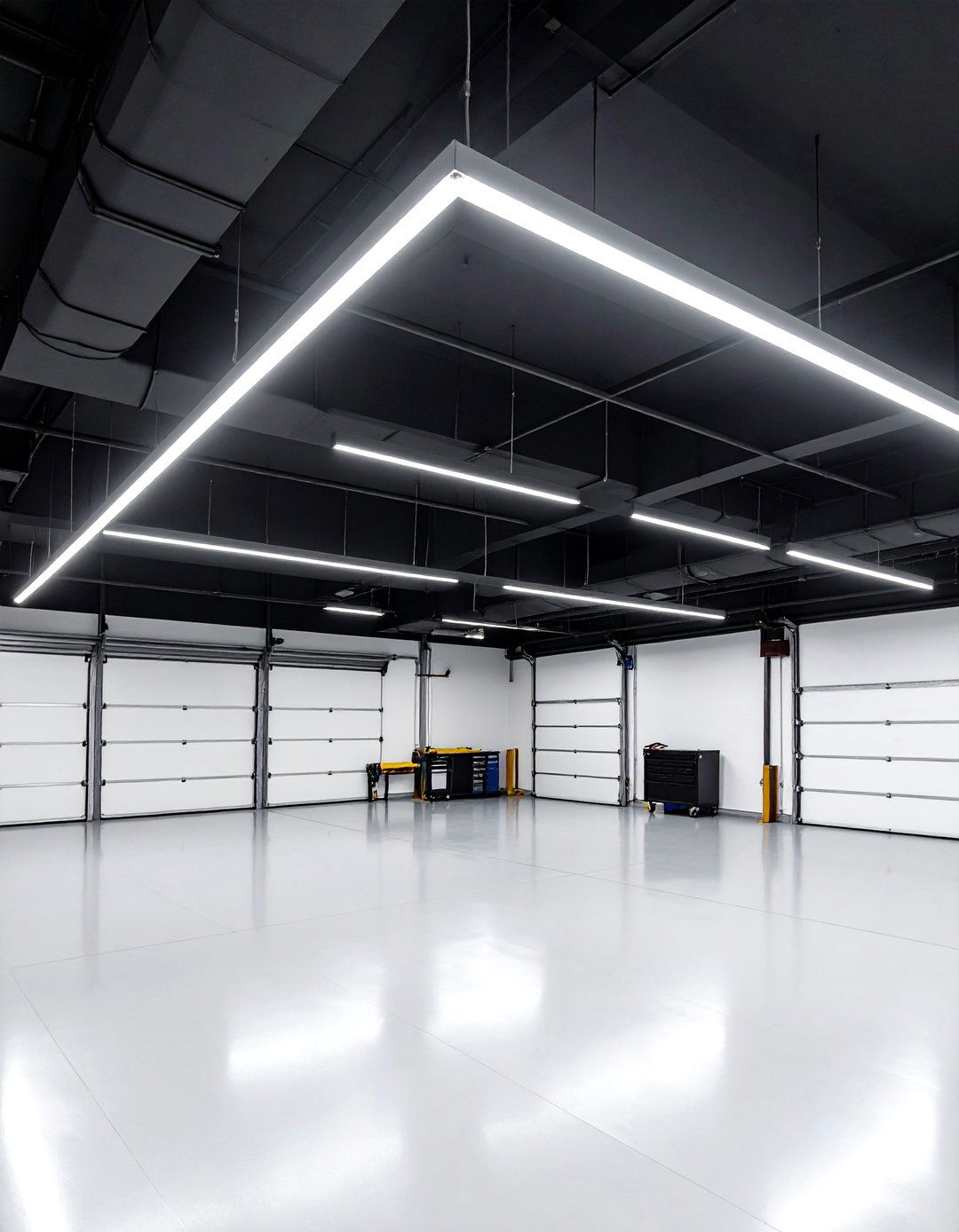
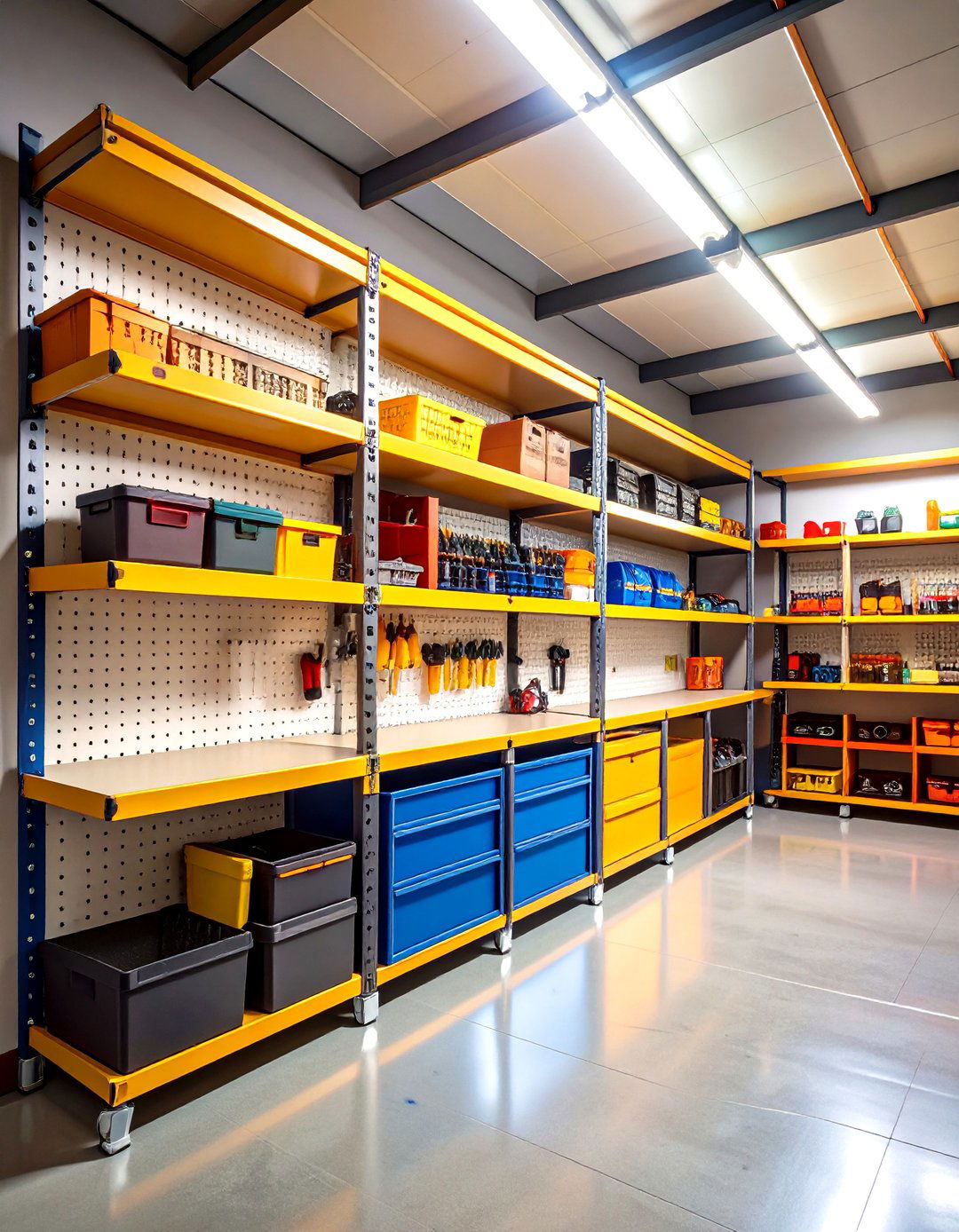
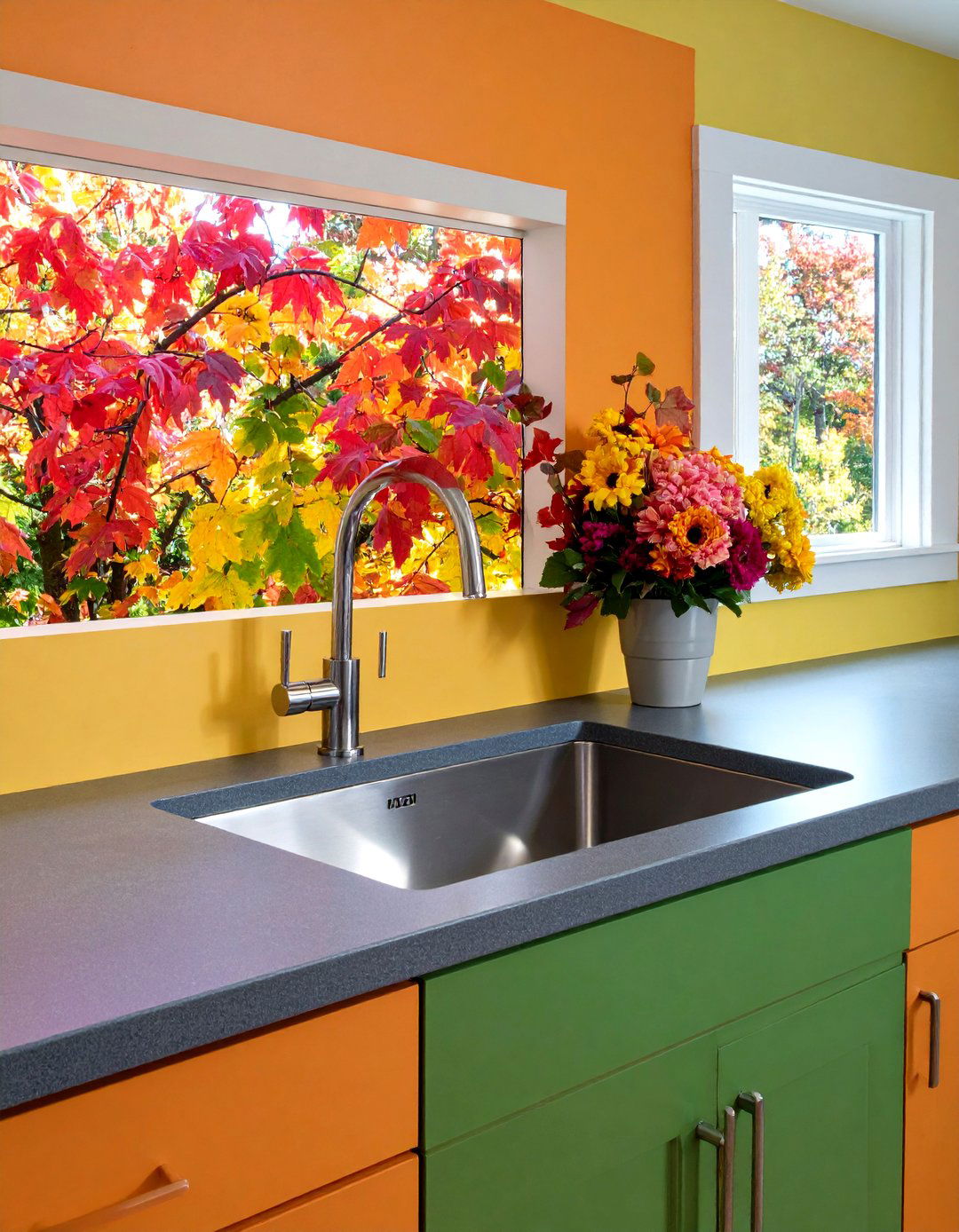
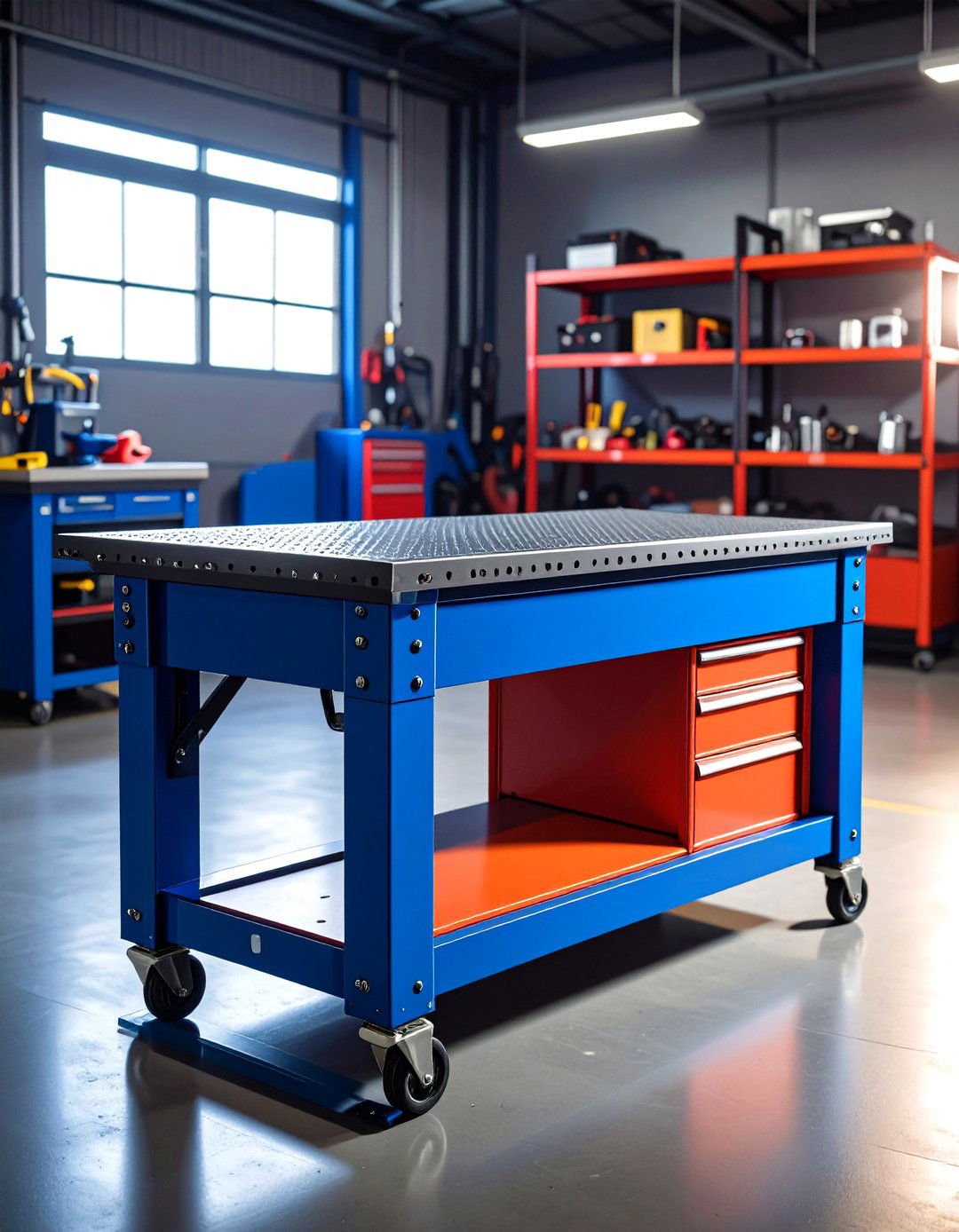
Leave a Reply